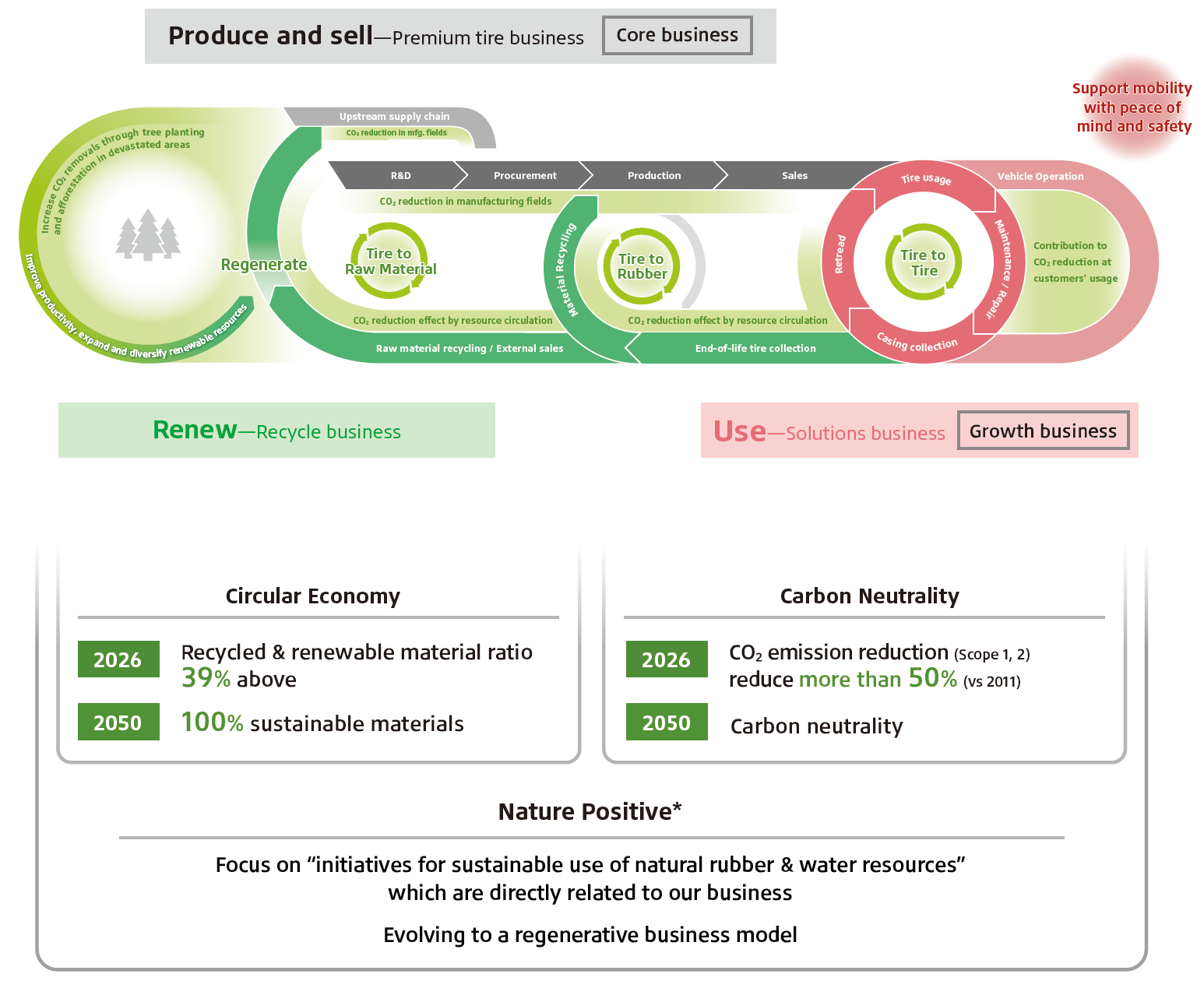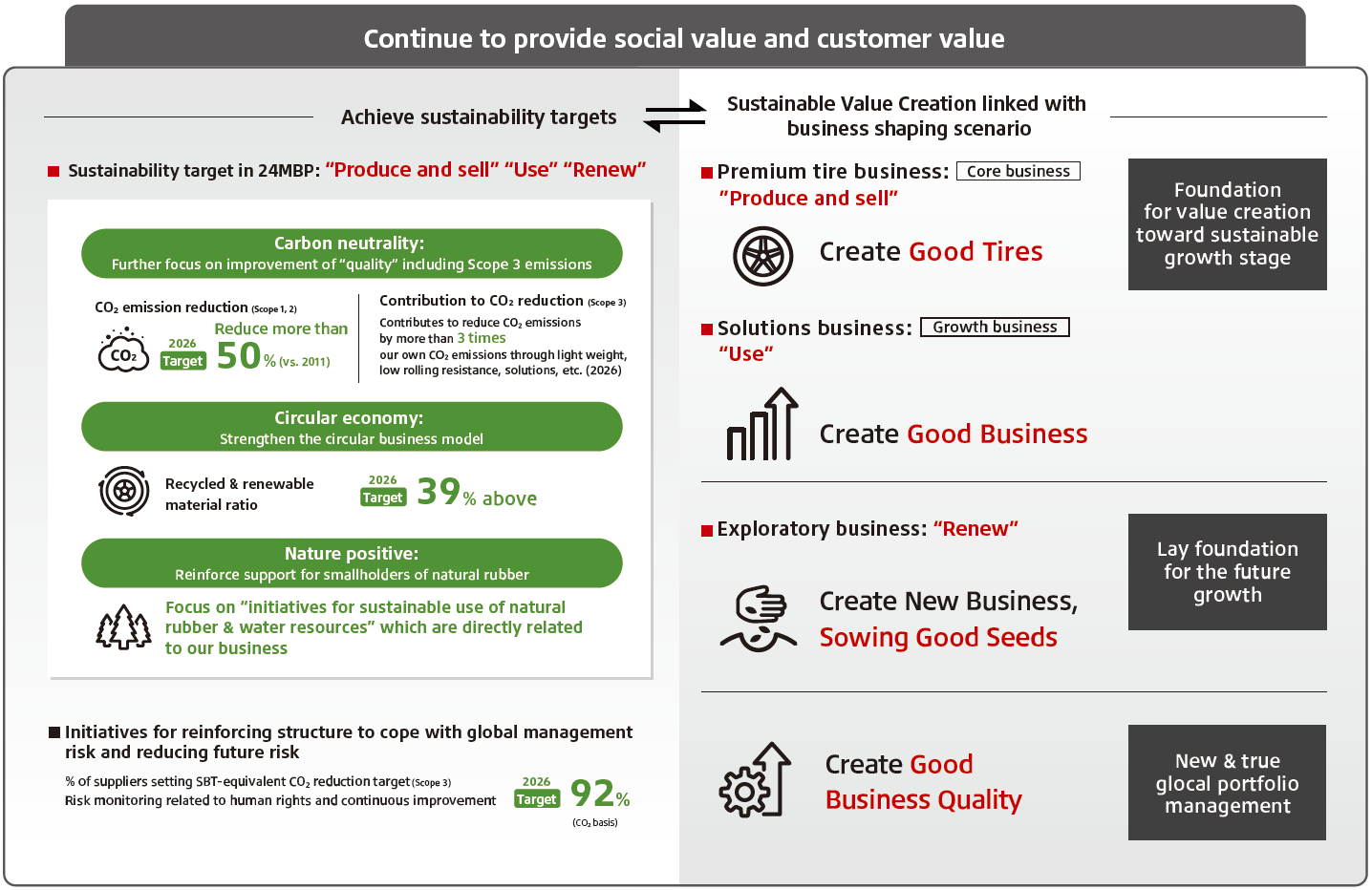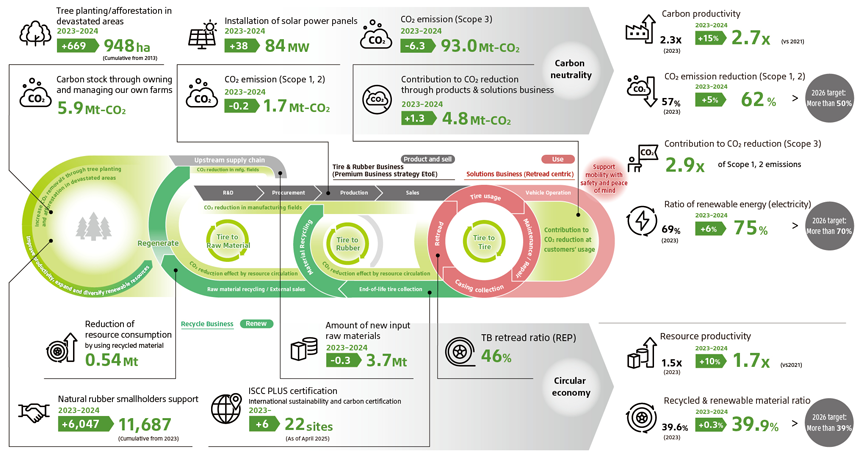Sustainability Business Model
Guided by its mission of “Serving Society with Superior Quality”, and positioning 2020 as its “third foundation”, Bridgestone is accelerating its transformation by placing sustainability at the core of its management and business, and promotes business activities with the aim of achieving sustainable growth as a company while contributing to the realization of a sustainable society. In order to realize its vision of “Toward 2050, Bridgestone continues to provide social value and customer value as a sustainable solutions company,” the Group is taking on various challenges and initiatives to build a foundation for sustainable value creation.
By incorporating sustainability into the corporate strategy and the Mid Term Business Plan, Bridgestone is working to establish a unique Sustainability Business Model that links its business with realization of carbon neutrality and a circular economy across the entire value chain, from “produce and sell” and “use” to “renewal” of tires to raw materials.

* It means halting and reversing the loss of biodiversity and natural capital in order to put nature on the path to recovery. The intent behind is to reduce the impact of business activities on biodiversity and natural capital, maintain and restore nature’s bounty, and transform socio-economic activities for sustainable use of natural capital.
Over the years, Bridgestone has shown a commitment to living in harmony with nature, based on its Environmental Mission Statement, which was refined in 2011. Bridgestone has been implementing initiatives to achieve its vision of “living in harmony with nature” in order to reduce CO2 emission and tackle the urgent issue of global warming through technology development aimed at valuing natural resources. Bridgestone set its long-term environmental vision toward 2050 in 2012, and Milestone 2030, its mid-term environmental targets toward 2030 to realize this vision, was announced in 2020.
Bridgestone has set carbon neutrality as part of its long- term environmental vision for the lead up to 2050. To achieve this, Bridgestone has established a clear mid-term environmental target for 2030 of reducing Scope 1 and 2 emissions by 50% or more compared to 2011, and is pursuing initiatives to this end. Bridgestone’s reduction rate for Scope 1 and 2 CO2 emissions in 2024 was 62% compared to 2011, representing an even higher reduction than in 2023. By steadily improving energy efficiency through ongoing actions to save energy and by switching to electricity derived from renewable energy sources, Bridgestone achieved its mid-term target ahead of schedule for the second year in a row.
Taking the lead in the industry, Bridgestone has set mid- to long-term targets to help bring about a circular economy: using 100% sustainable materials by 2050 and using 40% of raw materials made from recycled or renewable resources by 2030. Bridgestone is making steady headway toward achieving these targets. The ratio of recycled and renewable materials reached 39.9% in 2024, exceeding the 2026 target of 39% for the tire business as a whole. This contributed to a reduction in new input raw materials equivalent to 540,000 tons.
To pursue nature positivity, under the Mid Term Business Plan (2024-2026), Bridgestone is focusing on “initiatives for sustainable use of natural rubber & water resources,” that are directly linked to its business. As its stance for External Environment of Natural Rubber, Bridgestone set targets and indicators related to our contribution to Nature Positive, which is to support 12,000 smallholders by 2026. In 2024, Bridgestone supported 6,047 smallholders, bringing the cumulative total to 11,687 by the end of 2024. Bridgestone develops support activities for smallholders in collaboration with local communities, with the aim of improving yields per hector for smallholders and enhancing their livelihoods while contributing to reducing environmental impact at the same time. To pursue the sustainable use of water, in line with the Water Stewardship Policy, by 2030 Bridgestone aims to develop and implement specific water stewardship plans tailored to the local environment of each manufacturing facility located in a water stress area*. All 17 such facilities had formulated their own water stewardship plan as of the end of 2024, achieving a combined 5.4% decrease in water withdrawal in 2024 versus the previous year.
*Areas with risk of deterioration of freshwater resources in terms of quantity and quality
Sustainable Value Creation Linked to Business Shaping Scenario
In the Mid Term Business Plan (2024-2026), Bridgestone has integrated sustainability into its business shaping scenario, linking business activities with sustainability initiatives and working to build a foundation for sustainable value creation. The plan links its efforts to achieve carbon neutrality, a circular economy, and nature positivity to value creation in the core, growth, and exploratory businesses within the business shaping scenario. In this way, Bridgestone is evolving a more regenerative business model.
In its core business of premium tires, Bridgestone is improving the various areas of performance demanded of tires, including wear resistance, long life, and lower rolling resistance, through the expansion of ENLITEN, its base technology for product design, which pursues “ultimate customization”, and by simplifying development and production under BCMA, its base technology for manufacturing, while also boosting resource productivity and energy efficiency. In this way, Bridgestone is pursuing tire manufacturing that enhances customer value while reducing business costs and environmental impact, thus contributing to the achievement of its sustainability targets.
In the solutions business, Bridgestone is increasing the ratio of recycled and renewable materials by expanding the TB retread tires business, which operates on a circular business model, while also contributing to greater reductions in Scope 3 carbon emissions through proposals for optimal transportation routes in mobility solutions.
Through these efforts, Bridgestone aims to link business and sustainability, creating synergistic effects as two wheels, and promote the sustainable value creation, while reinforcing our sustainable structure and foundation.

Bridgestone will continue to work to build up the Sustainability Business Model while addressing the expectations of society and the needs of customers. At the same time, by evolving the business model into one that is more circular and regenerative, Bridgestone will create outcomes for a sustainable society, leading to the ongoing creation of social value, customer value, and corporate value.

